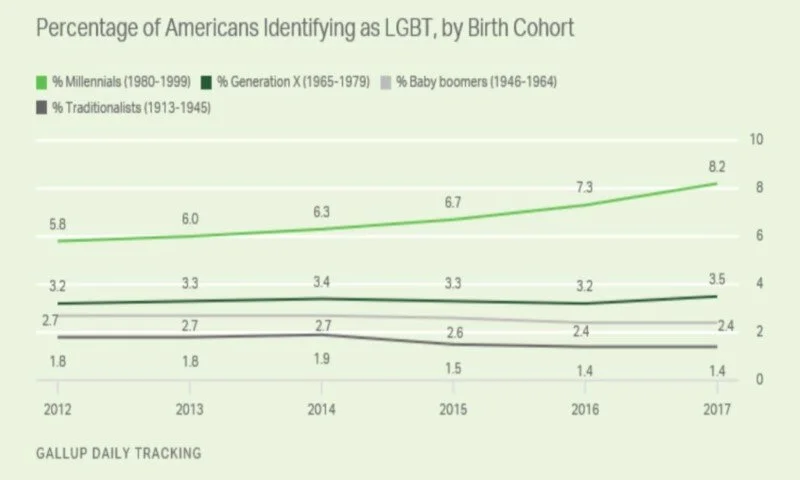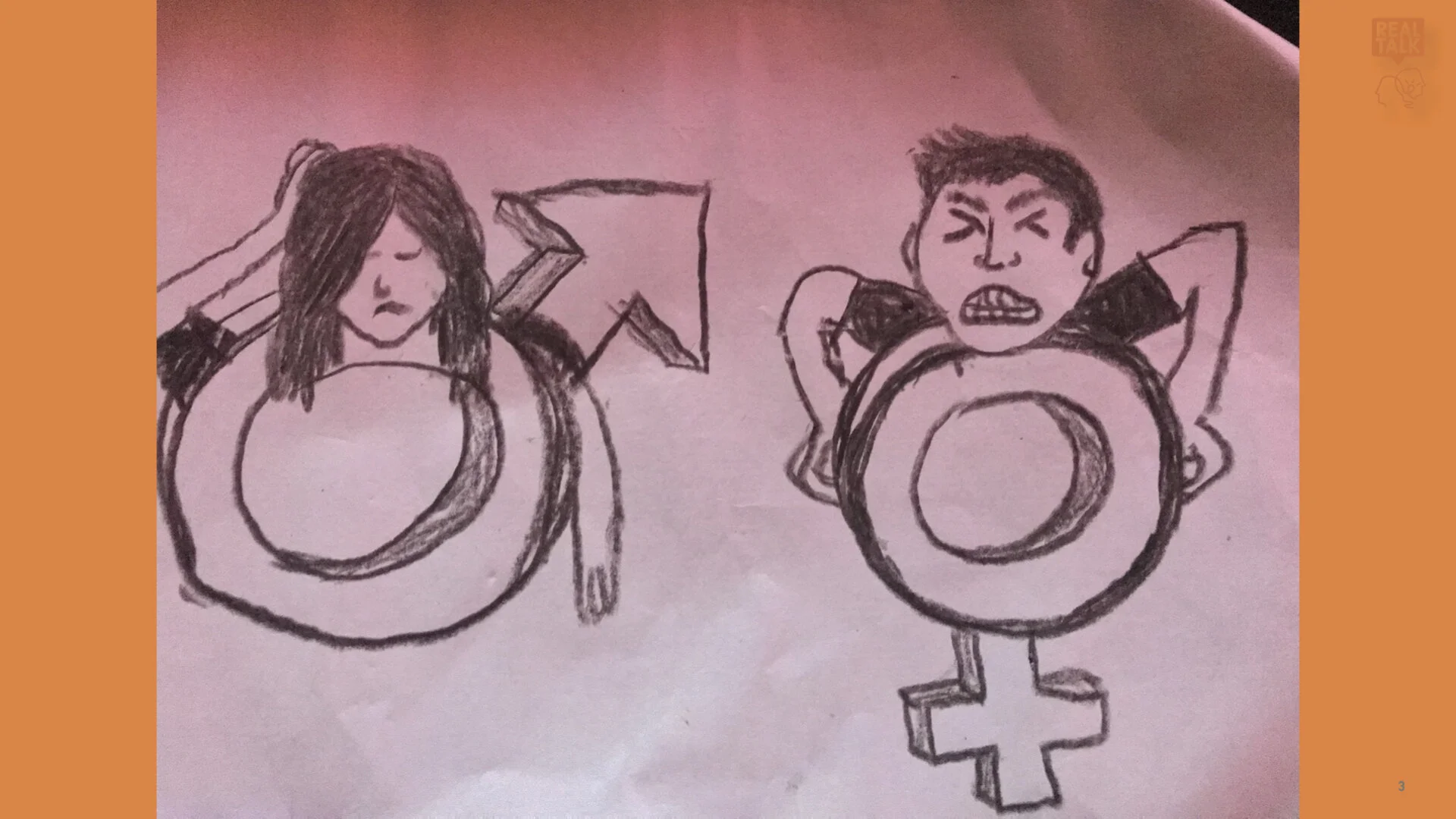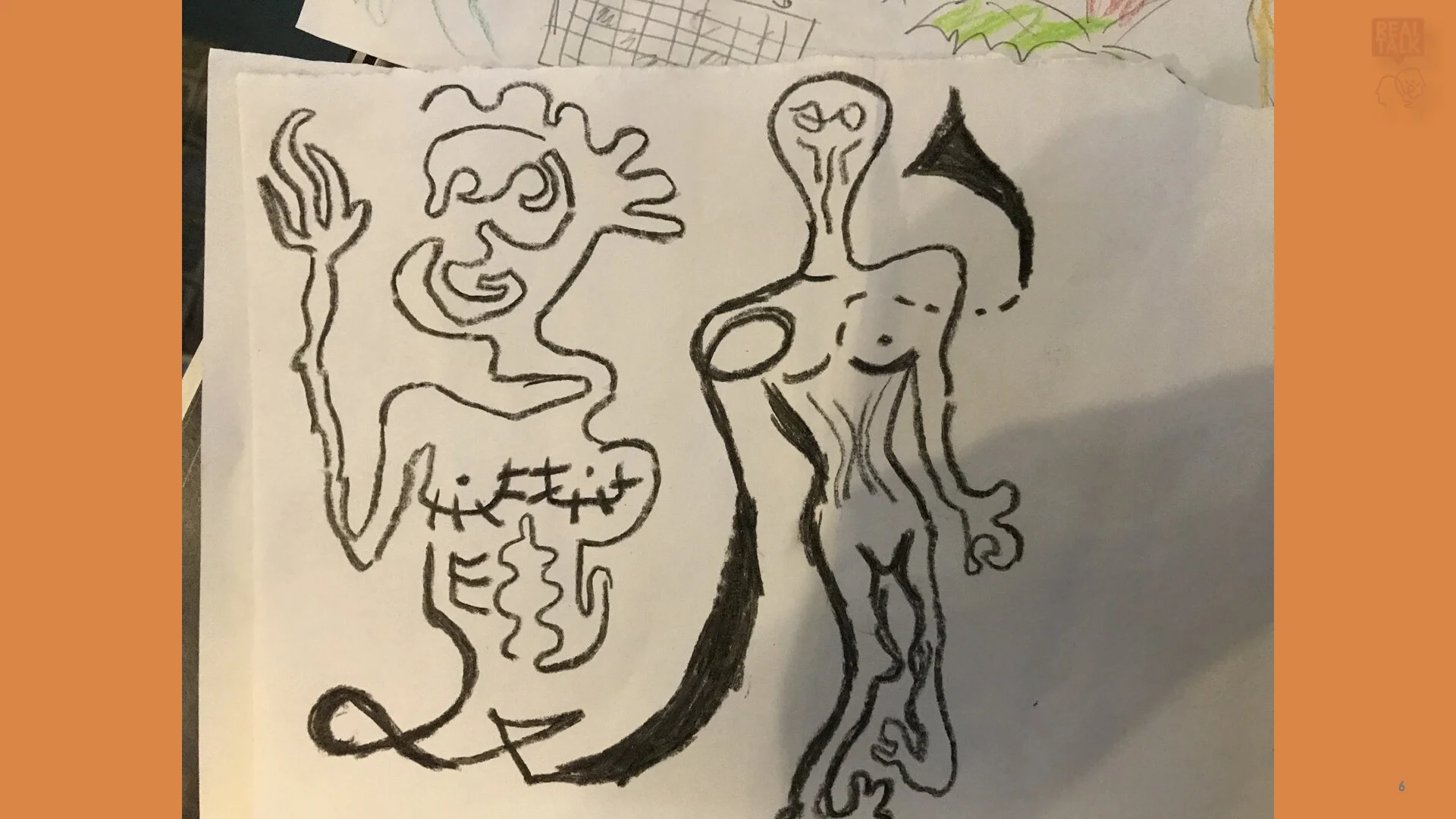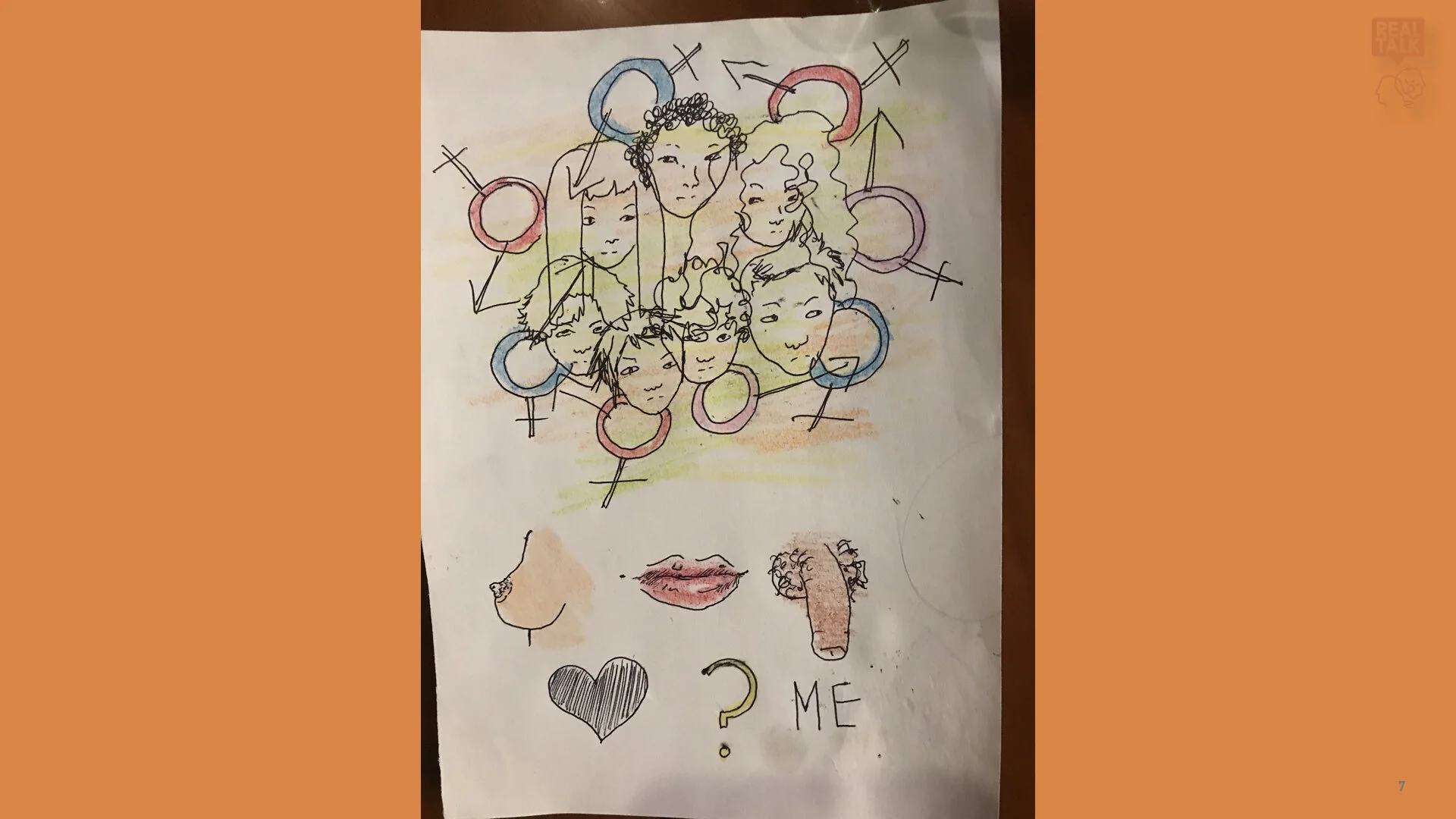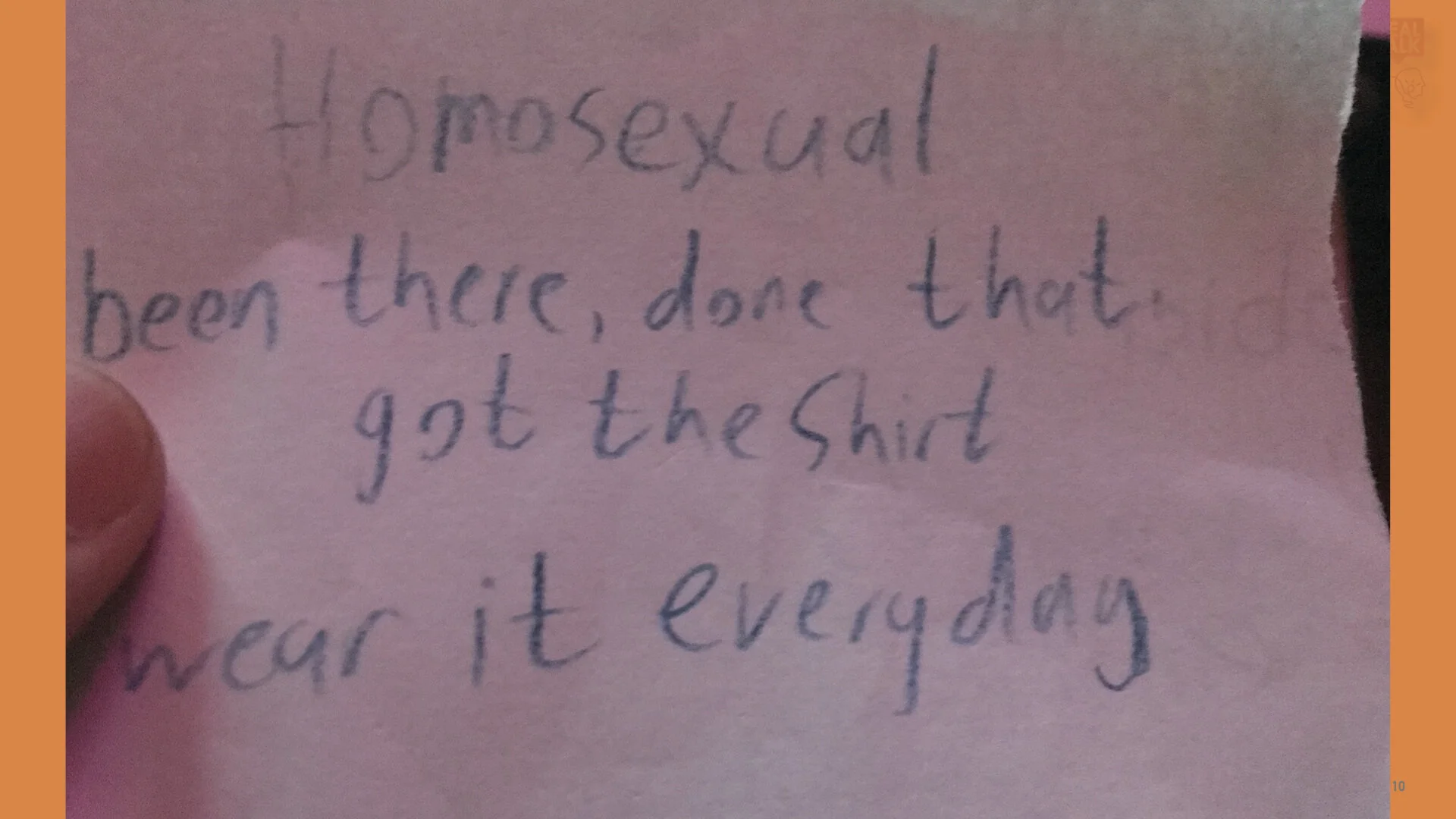Sexual Orientation
Real Talk Philosophy Artwork
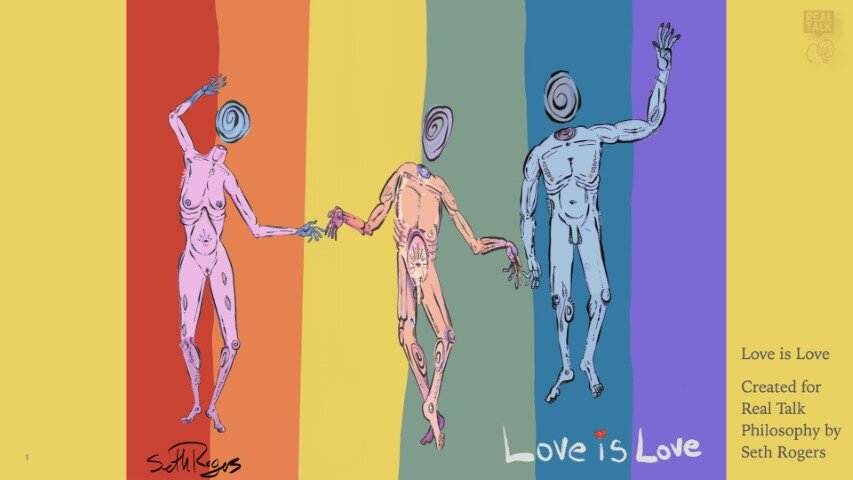
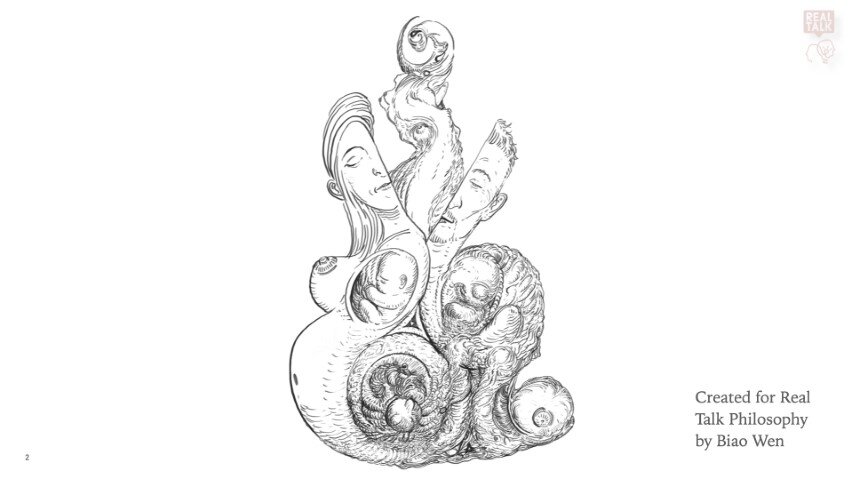
Introductory Discussion Question
What do the words gay, straight, bi, asexual, queer, trans, etc. mean?
What is your sexual orientation?
Is sexual orientation nature, nurture, or something in between?
Why do the flamboyant/butch stereotypes exist?
How can non-heterosexuality be reconciled with Darwinism?
What is Sexual Orientation?
The image below is the Westboro Baptist Church of Topeka, Kansas, USA - a group who infamously pickets around the funerals of dead soldiers and AIDS victims with signs that say “DEATH PENALTY 4 FAGS,” “SAME-SEX MARRIAGE DOOMS NATIONS,” etc.
Where does this homophobia come from? Is it in our biology? Or is it something we’re taught? Many blame religion. But, if religions were invented by humans, why did humans inject homophobia into religion?
People are deeply divided over their beliefs in the origins of sexual orientation. According to the PEW Research Center, as of 2020, more than ¼ of Americans believe that homosexuality should not be accepted by society. As of 2015, 1/2 of Americans believe that sexual orientation is not genetic. It is either a choice (42%) or the result of upbringing (8%).
According to the American Psychological Association "sexual orientation is most likely the result of a complex interaction of environmental, cognitive and biological factors.”
General Statistics
According to the UCLA School of Law, In the USA, about 4.5% of adults identify as LGBT. Of course, many other letters can be added to the rainbow, but this is how the question was phrased by UCLA. Slightly more females self-report as LGBT than males. 5.1% female, 3.8% male. Different estimates from around the world range from 3-16%. Interestingly, according to UCLA, Homosexual men earn on average 11% less than their heterosexual counterparts. Whereas Homosexual women earn on average 9% more than their heterosexual counterparts. Now, why might this be? Also, 25% of individuals below the poverty line identify as LGBT.
According to a 2017 Gallup poll, American millennials are increasing the rates at which they identify as LGBT, nearly doubling from 5.8% in 2012 to 8.2 in 2017. Oddly, in that same time period, there has been a slight decrease in LGBT identification from Baby Boomers and Traditionalists.
LGBT and Mental Health
According to a 2010 study published in the American Journal of Public Health, 40.8% of gay women and 57.8% of bisexual women suffer from an anxiety disorder, compared to 31.3% of straight women. These “anxiety disorders” include major depression, dysthymia, mania, hypomania, panic, social phobia, specific phobias, and generalized anxiety disorder. Also, members of the LGBT community have a much higher likelihood of attempting suicide. According to the Suicide Prevention Resource Center, 3% of heterosexual youth have attempted suicide, 28.1% of gay or bisexual youth, and 54% of trans youth.
Freud on Homosexuality
One of the first psychologists to write about homosexuality, quite divisively, is Sigmund Freud. Freud believed that all humans are bisexual. More specifically, he believes that everyone incorporates aspects of both sexes and that everyone is sexually attracted to both sexes. Freud believed that heterosexuality and homosexuality both developed from an original bisexual disposition and that homosexuality is caused, in part, by some distressing heterosexual experience early on in life. Freud was undecided as to whether or not homosexuality was an illness.
In 1935, Freud wrote to a mother who had asked him to treat her son's homosexuality. In response, Freud wrote:
“I gather from your letter that your son is a homosexual… Homosexuality is assuredly no advantage, but it is nothing to be ashamed of, no vice, no degradation; it cannot be classified as an illness; we consider it to be a variation of the sexual function… Many highly respectable individuals of ancient and modern times have been homosexuals… (Plato, Michelangelo, Leonardo da Vinci, etc)…
“By asking me if I can help [your son], you mean, I suppose, if I can abolish homosexuality and make normal heterosexuality take its place. The answer is, in a general way we cannot promise to achieve it. In a certain number of cases we succeed in developing the blighted germs of heterosexual tendencies, which are present in every homosexual; in the majority of cases it is no more possible.”
Conversion therapy
Freud’s views on sexuality were heavily influenced by Eugen Steinach, a Viennese endocrinologist - a type of doctor who identifies and treats hormone irregularities. Steinach is known to have employed some of the earliest and strangest gay conversion therapies, once transplanting the testicles of straight men into the sacs of gay men. And, unfortunately, this was not the end of the practice of obscure and horrific attempts to “cure” a person’s non-heteronormativity.
“Homosexuality Can Be Cured”
Here, we see a Christianity Today article from 1969.
“New Theory Claims Homosexuality Can Be Cured!”
“Modern medicine sees deviation as physical problem-disputing old belief that homos are made-not born!”
According to the American Psychological Association, conversion therapies are any “methods used in attempts to change the sexual orientation of homosexual and bisexual people to heterosexuality”
There are conventional psychological interventions, like talk therapy and group therapy. There’s also Systematic Desensitization, which is similar to exposure therapy, in that it is used to overcome general phobias. Those who support Systematic Desensitization believe that homosexuality is often caused by men being afraid of women. So gradual exposure to women is believed to be a cure for homosexuality. First with photos of women, then videos of women, then perhaps puppets, then short non-sexual encounters with women, then long non-sexual encounters with women, etc. until the men feel brave enough to release their “heterosexual inhibitions.”
In the 1960s, Aversion Therapy became popular for trying to “treat” homosexuality. Aversion Therapy, in general, works by pairing an unwanted habitual behavior with something discomforting. Since 1994, the American Psychological Association has declared that aversion therapy is a dangerous practice that does not work, but it is still in use in some countries.
in his 2007 book Coming Out Straight, Richard Cohen, a self-described “functioning heterosexual” - meaning that he has homosexual impulses but does not act on them - described his methods of “Bioenergetics”. Cohen holds male patients in his lap, often with the patient curled into the fetal position. Cohen argues that by experiencing male touch in a non-sexual context, this will decondition the brain from homosexual attraction. Cohen also advocates methods involving shouting or slamming a pillow with a tennis racket.
Perhaps one of the more disturbing conversion therapies, covert sensitization treatments pair homosexual images with disgusting images like vomit, feces, and dead animals. Some methods also direct patients to ingest nausea-inducing drugs while showing them same-sex erotica.
Throughout the 1940s and 50s, lobotomies were performed in the US to “cure” homosexuality. Walter Freeman, the American Neurologist who popularized the ice-pick lobotomy as a treatment for homosexuality, performed as many as 3,439 lobotomies. He had no formal surgical training.
Conversion therapy
Until 1990, homosexuality was classified as a mental disorder by the WHO.
According to the UCLA Williams Institute, as of 2019, roughly 77,000 youth (that is, children between the ages of 13-18) receive conversion therapy annually, 20,000 from licensed healthcare professionals, and 57,000 from unlicensed religious or spiritual advisers.
According to the APA, There have been no studies of adequate scientific rigor to conclude whether or not such methods work to change sexual orientation.
Arguments that Sexual Orientation is a Choice
The belief in the efficacy of conversion therapy treatments relies on the belief that sexual orientation is malleable and there has been a long history of arguments claiming just that.
First they say that homosexuality is clearly unnatural. If homosexuality were natural, this would create a Darwinian Paradox. According to Darwin and accepted modern evolutionary biology, those beings with traits that aid survival survive and pass their genes on. Therefore, any trait we have today must have served us for survival and reproduction at some point. But homosexual behavior doesn't result in offspring, therefore it must not be natural and so its practice must be a cognitive choice, not an impulse.
Another argument that sexual orientation is a choice, relates to sexual trauma. Past sexual abuse victims are more than twice as likely to exhibit homosexual behavior or identify as homosexual as adults. This might imply many things. Perhaps this implies that the experience of sexual trauma influences a person to one day identify as gay. Perhaps this implies that pedophiles are more likely to prey upon gay youth.
One controversial figure in the discussion over the origins of sexual orientation is Dr. Robert Spitzer. In the 1970s, Dr. Robert Spitzer became known as a major player in the destigmatization of homosexuality. In 1973 he led a successful effort to remove homosexuality from the DSM (The Diagnostic and Statistical Manual of Mental Disorders) and to stop treating homosexuality as a mental illness. By removing it from the DSM, homosexuality was seen as a standard difference rather than a disorder.
But, in 2001, Spitzer presented a divisive article titled "Can Some Gay Men and Lesbians Change Their Sexual Orientation? 200 Participants Reporting a Change from Homosexual to Heterosexual Orientation.” This study consisted of interviews with 200 people who claimed that their respective sexual orientations had changed from homosexual to heterosexual after receiving some form of conversion therapy. Spitzer argued that his study "shows some people can change from gay to straight, and we ought to acknowledge that.” After years of receiving criticism and defending himself, finally in 2012, Spitzer retracted his study, saying “"In retrospect, I have to admit I think the critiques are largely correct… The findings can be considered evidence for what those who have undergone ex-gay therapy say about it, but nothing more."
Dr. Robert Spitzer’s retraction points to a distinction that’s critical when having nuanced conversations about the origins of sexual orientation. And that is the distinction between sexual orientation and sexual orientation identity. Though these two terms are often not distinguished, it is essential for us to recognize that it’s possible to be gay while identifying as straight, and it is possible to be straight while identifying as gay. And many survivors of gay conversion therapy may identify as straight, without their sexual orientation changing. It appears that the majority of sexual health professionals consider sexual orientation to be unchangeable, but recognize that a person’s sexual orientation identity may change over a lifetime.
Discussion Questions
If we were to identify an unequivocal “gay gene,” should we allow parents to pre-screen fetuses for it when making abortion decision?
Is homosexuality exclusively human?
Why do homophobia and transphobia exist?
Why is LGBT disproportionally millennial?
Why is there an overrepresentation of LGBTQ+ people below the US poverty line?
At what age should children begin exploring their sexual identity and expression?
Should gay conversion therapies be legal for consenting adults?
Which should be more highly regarded - sexual orientation or sexual orientation identity?
Does sexual fluidity exist?
Sexual Orientation is Genetic
So now, let’s take a look at some of the scientific literature showing that sexual orientation is genetic.
(DISCLAIMER: Unfortunately, right now, there is a lot more data about gay males than about gay females. And it appears that the mechanisms influencing biological sexual orientation in men are similar but different than those in women.)
Genes and sexuality
Andrea Ganna, a geneticist for the Broad Institutes, at the American Society of Human Genetics meeting in San Diego, said:
“There is no single ‘gay gene’, sexuality cannot be reduced to a single trait. Rather, non-heterosexuality is in part influenced by many tiny genetic effects and environmental components.”
Some geneticists agree with Andrea. Others disagree. In 1993, geneticists began to focus on the Xq28 genetic marker. This was soon known as the “gay gene.” But geneticists argued that this should not be referred to as a “gay gene” but rather a “male loving gene” because, whether male or female, whoever has the Xq28 genetic marker has an increased likelihood of loving men. Technically, this is not a gene, but a cluster of genes in the Xq28 region. But it is commonly referred to simply as the Wx28. The Xq28 is common in females, but uncommon in men. When present in a male, he is predisposed to homosexuality. When present in a female, she tends to have children early and plentifully. But in 2019, a far more thorough study was conducted with 493,001 participants from the USA, UK, and Sweden. Looking at the full genomes of these patients provided by UK Biobank and 23andMe, researchers identified five gene clusters that appear to influence sexuality. But none of these five can be used to individually predict sexuality. The researchers state that no single gene dictates sexual orientation. They write “In aggregate, all tested genetic variants accounted for 8 to 25% of variation in same-sex sexual behavior, only partially overlapped between males and females, and do not allow meaningful prediction of an individual’s sexual behavior.”
Hormones and Sexuality
Beyond genes, there are hormonal factors that appear to influence sexual orientation as well. For example, DES, Diethylstilbestrol, is a strong synthetic oestrogen, prescribed to women to prevent miscarriages. Since the 1980s it has been found that those who are exposed to DES in the womb are more likely to identify as non-heterosexual. Another is Testosterone. According to a 2017 study, exposure to testosterone while a baby is still an embryo increases non-heterosexuality in females. Also, PCOS (Polycystic Ovary Syndrome) - which results in irregular or no menstrual periods, heavy periods, excess body and facial hair, acne, pelvic pain, and more - was found to be positivity associated with homosexuality in women.
Finger length ratio
Another argument for the genetic basis of sexual orientation is Finger Length Ratio. “2D:4D” refers to the ratio between the lengths of the 2nd and 4th fingers. Or, 2nd and 4th “digits.” That is, the length of the index finger divided by the length of the ring finger. Researchers have repeatedly found that lesbian women have a lower digit ratio, on average, than heterosexual women. A lower digit ratio is usually caused by higher androgens (like testosterone) in utero. Studies on digit ratio and homosexuality in men are inconsistent. Low digit ratio also predicts monogamy.
Positive Gay Character traits
In response to the claims that homosexuality is not natural because it serves no survival advantage, E. O. Wilson, 2-time Pulitzer prize-winning Biologist, once postulated “Homosexuality may give advantages to the group by special talents, unusual qualities of personality, and the specialized roles and professions it generates.”
So what might these specialized roles be?
According to a 2012 article by Satoshi Kanazawa called “Intelligence and Homosexuality,” published in the journal of biosocial science, LGBTQ people tend to have higher levels of emotional intelligence, Gay people have slightly higher IQ scores, and gay males tend to score higher in metrics of compassion and cooperation than straight males, lower in metrics of hostility. Kanazawa is not arguing that all gay men are hyper-compassionate. But that, on average, gay men are.
Dan Savage, LGBT community activist and host of the Savage Love podcast, believes that gay people exist because, in the event of war, it’s extremely beneficial for the survival of a community to have a group of males who do not want to go to war. So when some of the soldiers are killed, their children will still have father figures (in many cultures the woman’s brother, not the husband, is responsible for taking care of the children). Gay men have the role in society to be the caretakers of deceased fathers. And yet we’re the ones who aren’t allowed to adopt?
But, Dan Savage’s theory is just a theory. Is there any science to back up these claims? James H O'Keefe, MD, is a Director at Saint Luke’s Mid America Heart Institute. When James’ son came out to him as gay, James did not know how to respond. He did not understand how people could be gay. So he devoted a significant chunk of his study to the origins of sexual orientation. He says, “If all males were gay, that would be a problem. But if all males were warriors, we'd always be at war. The recipe of a successful human culture is a synergy of many different ingredients.”This searching led him to epigenetics, the study of how your behaviors and environment can cause changes that affect the way your genes work.
Epigenetics
PLEASE NOTE: Epigenetics is still a relatively new field of genetics. And there is a lot we do not know. So most of the current science on epigenetic is speculative.
To help understand the power of epigenetic, let us consider ants.
The big ant is a soldier ant, the rest are worker ants. These two ants are identical twins. Their genetic codes are exactly the same. According to James O’Keefe, “The queen epigenetically orchestrates this by placing different epigenetic tags on the developing ants. She places tags when the colony is under attack to uncoil the DNA to make the soldier. But when the colony is hungry, she puts different tags to uncoil the DNA and epigenetically create the worker. In this way, the dynamic power of epigenetics changes our genetic expression so that we're born with traits that allow us and our families to succeed in the current conditions.”
James O’Keefe says that “You probably have gay genes in your DNA. But unless they were turned on, in your mother’s womb, they remain curled up and silent.”
One of the most interesting epigenetic findings in relation to sexual orientation is known as the Fraternal Birth Order Effect. According to a study in 1997, “The more older brothers a man has from the same mother, the greater the probability is that he will have a homosexual orientation.” That is, for every older brother a male has, the chances of being gay increases 33%. So if a male has no older brothers, his likelihood of being gay is about 4%. With one older brother, his likelihood of being gay is 5%. With 2 older brothers, his likelihood is 7%, with 3 older brothers, 9%, 4 older brothers, 12%, and so on. This is also consistent in adoptees and step-families. If according to biological birth order, a male is the 4th-born son, but he is adopted into a family where he is the oldest son, he will still have a 33^3% (or 58%) increase in likelihood of being gay. Homosexuality in the general population is only about 4%. So a 33% increase isn’t much, but it is enough to be significant. Interestingly, the birth order effect is not influenced by the number of older sisters. Birth order also doesn’t appear to affect female sexual orientation at all.
Maternal Relative Increased Fecundity
Researchers have found, however, that female relatives of gay men tend to have more children. The exact finding is that “maternal relatives of homosexuals have higher fecundity than maternal relatives of heterosexuals”. Fecundity is a measure of a persons ability to produce an abundance of offspring. It is a near-synonym to the word fertility, but is applied to both men and women.
Table 2 shows that the mean fecundity (that is, the average number of children), of maternal aunts (that is, the mother’s sister) of gay men and women is 1.98. Compare this with the mean fecundity of the maternal aunts of heterosexuals, which is only 1.51. That’s a 31% increase.
Handedness
Another argument that sexual orientation is derived from biological factors, rather than being a choice, is its relationship to left-handedness. Handedness is determined very early in fetal development. So anything that is correlated with handedness is also likely determined early in fetal development. Humans are about 8% left-handed. Left-handedness (or, more specifically non-right-handedness) is correlated with many sexual tendencies. In terms of sexual orientation, a meta-analysis (conducted in 2000) of more than 20 studies found that gay people are on average 39% more likely to be left-handed. 24% more likely for males, 91% more likely for females. Also, transgender women have been found to be more than twice as likely to be left-handed (19.5% vs. 8.3%). Paraphilia is a sexual attraction towards non-sexual objects (shoes, panties, bubbles, etc.) A 2007 study found "elevated paraphilic interests were correlated with elevated non-right handedness.” Even asexuality has been correlated with non-right handedness. According to a 2014 study, asexual people are 2.4 and 2.5, respectively, times more likely to be left-handed. Also, perhaps uncomfortably, pedophilia is also positively correlated with left-handedness. According to a 2014 study, pedophiles are more than 3x as likely to be left-handed (25% vs. 8%). You may wonder why this last statistic is included in our list. There’s actually quite a lot of debate ongoing as to whether or not pedophilia should be considered a sexual orientation like gay, straight, asexual, and paraphilia.
Appeal to Nature Fallacy
Regardless, though, the question remains: why exactly does it matter whether a person’s sexual orientation is inherent or learned? All of the claims we’ve explored here fall under the domain of the Appeal to Nature Fallacy, a logical fallacy in which an attempt is made to argue that a thing is good because it is 'natural', or bad because it is ‘unnatural’ Just because something is natural doesn’t make it right. There are many things that are natural. Murder. Physical violence Rape. Making presumptions about what is natural and what isn’t has been used to justify the unequal treatment of gay people, people of color, women, and others for centuries. So this entire argument about which is more “natural” maybe is best to ignore.
Steven Rose, a neuroscientist and professor at the Open University, once wrote “What worries me is not the extent, if at all, to which our genetic, epigenetic or neural constitution and development affect our sexual preferences, but the huge moral panic and religious and political agenda which surrounds the question."
